In order to to get an idea of how I could bind my book I researched online the different methods. I found this usual list on Emily Duong's blog which I found helpful. After looking through the methods I think I am going to perfect bind my book. I will glue the edges then hopefully Put screws through it to finish it off. I am hoping the emboss the front cover.
Taken from this http://emilyduong.com/blog/a-visual-reference-bookbinding
Commercially Available Techniques
Saddle Stitched/Side Stitched
Spiral, Plastic Comb, Wire-O
Thermal Tape
Perfect
Case
Spiral, Plastic Comb, Wire-O
Thermal Tape
Perfect
Case
Custom Techniques
Japanese Stab
Saddle Sewn
Side Sewn
Screw Post
Coptic
Long Stitch
Secret Belgian
Saddle Sewn
Side Sewn
Screw Post
Coptic
Long Stitch
Secret Belgian
Commercially Available Techniques
The following are book binding techniques you can get from printers as a standard service. All of these can also be made by hand.
Saddle Stitched/Side Stitched
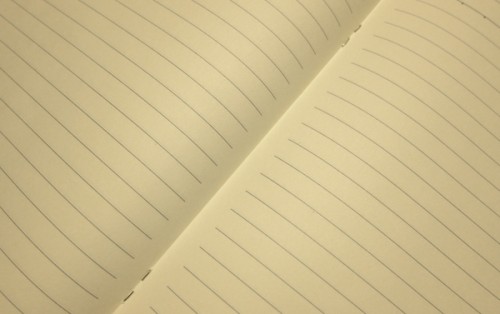
Method: Spreads folded and staples are applied on the spine from the cover to the center spread to hold everything in place.
Common uses: notebooks, programs, office presentations
Pros: Very cheap; staples are the only materials needed;
Cons: May make the product look cheap, depending on the design;
Spiral, Plastic Comb and Wire-O
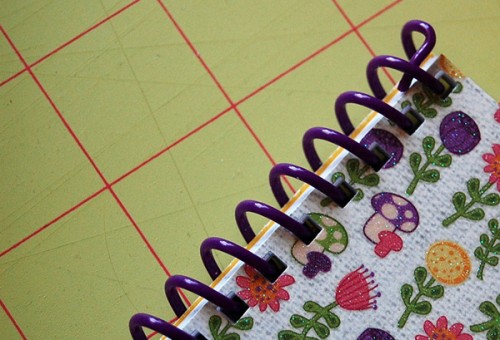
Spiral notebook photo from Flickr user SewPixie.
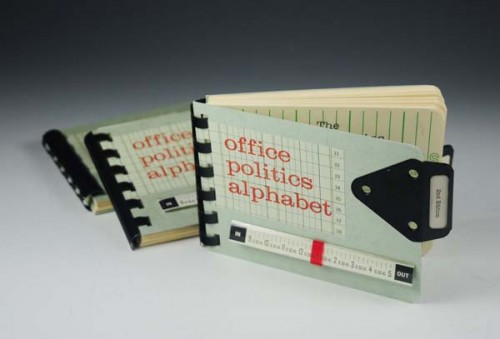
Plastic comb notebooks photo from Flickr user Abecedarian Gallery.
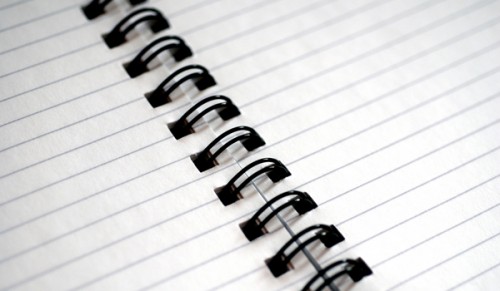
Wire-o binding from Flickr user incurable_hippie.
Method: Punched holes by the spine with a plastic or wire coil or comb looping through all the pages.
Common uses: notebooks, office presentations, planners, sketchbooks
Pros: Ability to lay spreads flat; ability to fold back the book without damaging the pages.
Cons: May make the product look cheap, depending on the design; coils are not recyclable and a hassle to remove;
Thermal Tape
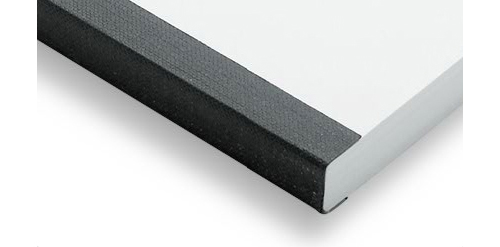
Photo from Mimeo.
Method: Creates a book by placing a strip, with one side adhesive, onto the spine and over the cover. Then the book is inserted spine side into a machine to heat the adhesive and add pressure to seal the edges.
Common uses: notebooks, notepads, office documents, manuals
Pros: Sturdy spine, very similar to perfect binding.
Cons: Exposed binding – can easily pick at the strip; getting text or graphics on the spine will be a custom job.
Resources: Here’s a demo/sale video from Accubind, a popular supplier of thermal tape binding machines. Unibind and velo is also similar. Mimeo also offers this service.
Perfect
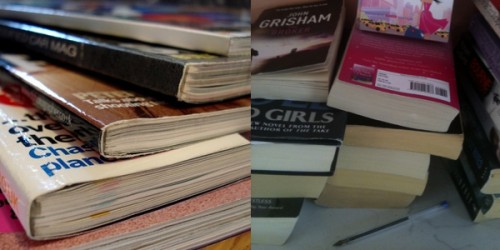
Left photo: from Flickr user bravenewtraveler; Right: from Flickr user dinoboy;
Method: Pages are glued on the spine, which needs to have a rough surface so the glue can stick easily, into a cover that wraps around the back, spine and front.
Common uses: paper back novels, magazines, catalogs
Cons: Does not allow for hardcover, so more susceptible to wear and tear’
Case
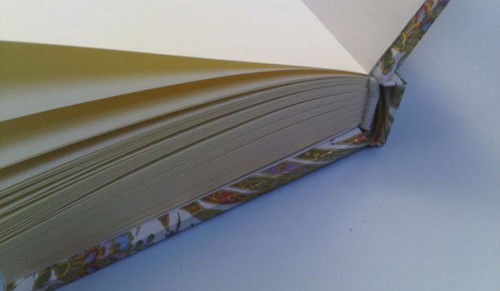
Photo from Flickr user natalee929;
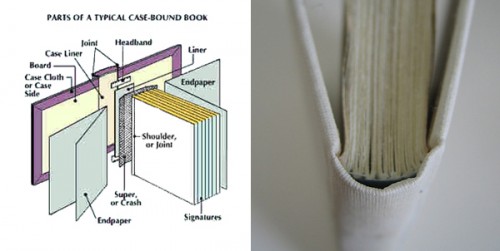
Left photo: diagram from Unique Bindery; Right: from Flickr user moirabot;
Method: Pages are divided into signatures then sewn together and adhered into a hard casing, traditionally cloth covered cardboard.
Common uses: textbooks, hardcover books, bibles
Pros: Hardcover creates a rigid product and protects the sheets inside better;
Cons: Time consuming to DIY; much more expensive than perfect binding;
Resources: Buy a case bound kit at Hollander’s (from $12 to $55); a 3 minute introduction video from the Kolbus plant; Tutorials from Angela Sutton, Douglas W. Jones at Univeristy of Iowa and Garry Harrison at Indiana University.
Custom Techniques
The following techniques are more of a hand crafted art form. They can be mass produced by a printing company, however, the cost per unit is much higher than the techniques described above. Please note these are not the only custom techniques, there’s no limit to how a book can be bound!
Japanese Stab
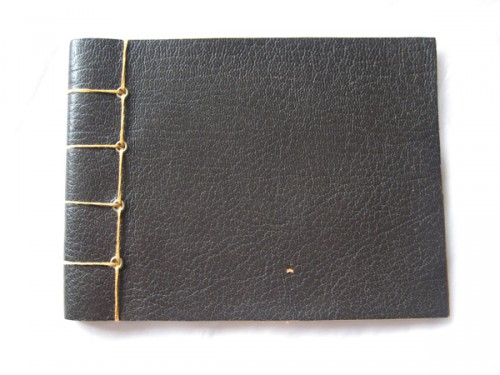
Image from Flickr user lindr;
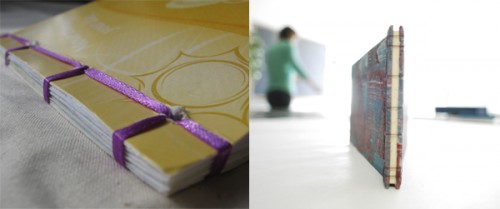
Left image from Flickr user henna lion; Right from Flickr user nsfmc;
Method: Binds loose pages using exposed thread that wraps around the spine and on the top and bottom of the book.
Resources: Buy a kit with all the materials needed at Dick Blick (starting at $20.89); APDF tutorial on this method from Bley Hack (via Vintage Indie); 9-minute video tutorialfrom CuriousDoodles;
Saddle Sewn
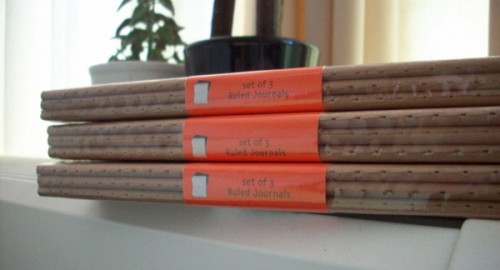
Image from Flickr user amy in holland;
Method: Collated pages are folded in half and sewn in the middle through the cover to hold everything in place.
Side Sewn
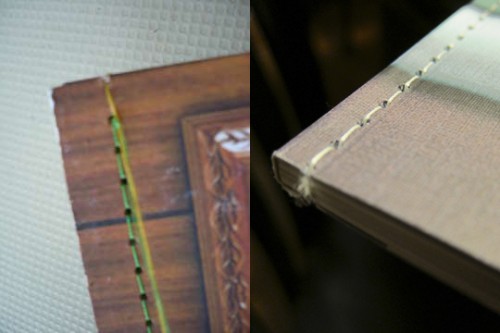
Left image: from Instructables user sepme; Right: personal photograph
Method: Loose pages and the cover (wrap or loose) are held together by sewing through all the pages from cover to cover, a certain distance from the spine.
Post Binding
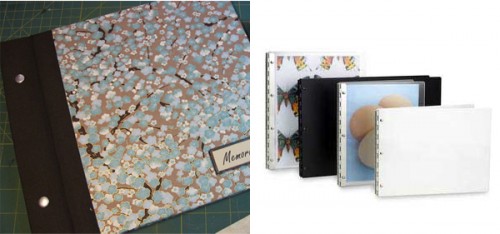
Left: from Flickr user Terry Tyson; Right: from Sam Flax;
Method: Holds in loose pages using screws that go through the cover and all the pages.
Common Uses: Portfolios, photo albums
Pros: Can easily change pages inside;
Cons: Hardware heavy – exposed metal;
Coptic
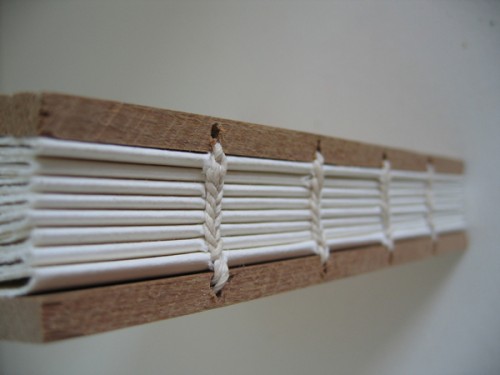
Image from Flickr user moirabot;
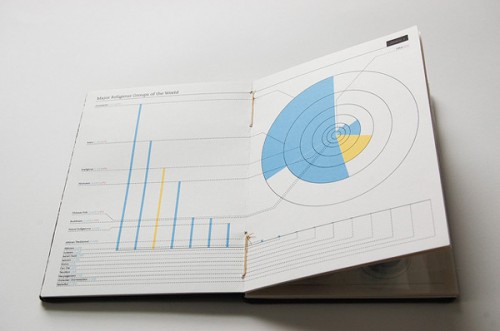
Image from Flickr user andymangold;
Method: Using signatures, these binding method has an exposed spine and threading that creates braids along the spine.
Pros: Allows the book to lay almost flat.
Resources: DIY Kit from etsy user WriteOwl; Video tutorial using boards & only two signatures from jaescala; Tutorial from Linda at Torta Gialla with lots of photos;
Long Stitch
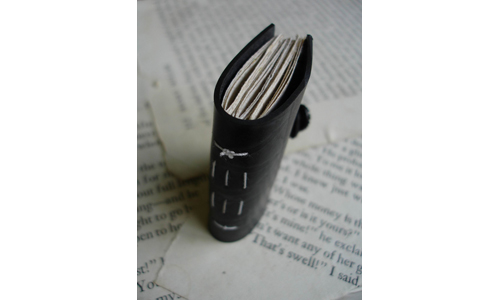
Image from Flickr user ashe-villain;
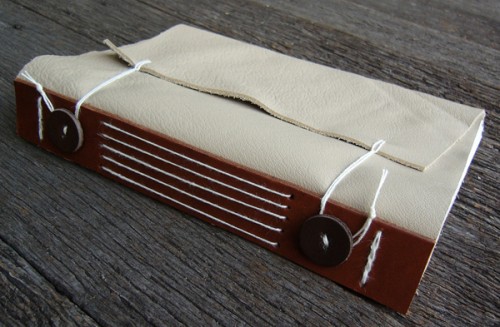
Image from Flickr user Jane Stockton;
Method: Also known as limp binding, signatures are individually bound to the spine, allowing for the creator to make unique patterns on the spine.
Resources: Another great photo heavy tutorial from Ling at Torta Gialla; Video tutorial on assembling the final product by Majhada Crafts;
Secret Belgian
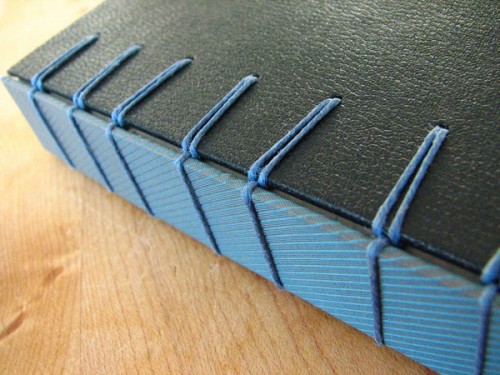
Image from Flickr user Dennis Yuen;
Method: No longer a secret (haha), this binding uses exposed threads, wrapping around the spine, covers and through the signatures inside.
Pro: Because signatures are used rather than flat pages, it allows the book to lay flat;
For smaller books, or books with thinner paper for pages, you may want to try plastic combs or spirals. This way, you can still create a new look for things such as scrapbooks, and make allowances for new pages with having to use paperclips or staplers. Plastic spirals will also add more security to the pages when the book is opened, so you won't have to worry about chasing missing pages every time you look through your favorite scrapbook or journal.
ReplyDeleteBook Binding Boston
Thank you very much!!! will take this into account next time I need to do some book binding.
DeleteThanks for sharing such a nice article. I love your writing. Your idea is mind blowing that's why i would like to appreciate your work.
ReplyDeletepresentation display boards
used print finishing equipment
Thanks for this blog I got information about Book Binding. I am really interested in bookbinding so this information is very helped full for me. I would like to know about Book Binding Screw Supplier. So please share information about this topic.
ReplyDeleteExcellent article,
ReplyDeletePrint books provides excellent book binding services at affordable price.